










BY CYDNEY HALPIN

Jersey Jazz LIVE! programming is on summer hiatus, but will return Sunday, October 6th with the presentation of the documentary Jimmy Van Heusen … Swingin’ with Frank & Bing. Creator, documentarist Jim Burns, and record/ radio producer, author, historian, and archivist Chuck Granata will join us for conversation, anecdotes, and share, rarely, if ever, seen photographs not included in the film. Live Jimmy Van Heusen music will also round out the program. Mark your calendars and plan on spending the afternoon Swingin’!
Admission is $10 members/$15 non-members. Doors open at 2:30 p.m., concert starts at 3:00 p.m. Light refreshments are available for purchase. Free street parking is available. Madison Community Arts Center, 10 Kings Road, Madison, NJ.
Perhaps you’d like to sponsor or co-sponsor a Jersey Jazz LIVE! event? Funding for the Jersey
Jazz LIVE! events has been made possible, in part, by funds from Morris Arts though the New Jersey State Council on the Arts/ Department of State, a partner agency of the National Endowment for the Arts. This program is also proudly supported by a grant from The Summit Foundation.
While we’re very grateful for this support, this funding doesn’t cover the full costs of our programming.
If you or someone you know would like to help sponsor or co-sponsor one of these programs, please contact me at pres@njjs.org or at 973229-0543 for more information.
The “Jazz on the Back Deck” series at the Morris Museum is in full swing and Saturday, July 13
will showcase the Evan Sherman Big Band. August will present the Harlem Quartet 8/1, vocalist Laura Anglade 8/10, The FUMOS 8/17, and vocalist Vanisha Gould 8/24. The series will end September 14th with ‘Blanc Après Labor Day’ with Mike Davis and the New Wonders. All shows are at 7:30 p.m. Bring a chair and a picnic. For tickets: morrismuseum.org/ outdoor-concerts-on-the-back-deck
Did spring cleaning find that you discovered a musical instrument abandoned by an aspiring musician of long ago? If your answer is yes, please consider donating it to NJJS, and we’ll make certain it’s delivered to The Paterson Music Project, a part of Wharton Arts.
Board colleagues Jay Dougherty, Sandy Josephson, James Pansulla, and I delivered a trove of instru-

ments—two trumpets, two flutes, two saxophones, a clarinet, and three music stands—last month to PMP, and had the opportunity to talk with Shanna Lin and Sam Tobias about the program, logistics, funding, etc.
It was a busy morning at their office, as the program’s rental instruments were being catalogued, sorted, and returned to K&S Music, prompting me to ask what kind of impact our donation would actually have on their organization. Sam was quick to reply that, ”Every instrument donated is one less instrument we have to rent, and allows funding to go farther!”
Studies prove that participation in music changes children’s lives! Please contact James Pansulla at jazzeducation@njjs.org or Jay Dougherty at singitjay@gmail.com if you have an instrument(s) you’d like to donate to NJJS. Arrangements
can be made for pick up or delivery.
Please NOTE: NJJS does not accept acoustic pianos, given the difficulty and expense of delivery of such a gift.
The Board of Directors and I would like to congratulate Chatham School District Band Director Brian Conti on his retirement. Conti has served as Director for the Chatham Community Band for 40 years and Band Director within the school district for 32 years. It goes without question that Conti has played a vital role in the personal and professional lives of so many young musicians. Perhaps student and future Texas A&M band member Andrew Cooper said it best when he described Mr. Conti as, “Unmatched. He’s a teacher that pushes you to become excellent and always stresses the importance music has on us. How it builds relationships.”
Congratulations Brian Conti on a job well done! We somehow doubt that you’re done with music and look forward to what’s next for you in retirement.
I’ve said it many times before, the people I’ve met in the jazz world are amazing cats! And meeting Samara Joy at NJPAC last week was no exception. Her voice is without question “other worldly” and her musicianship is off the charts! But it’s her upbringing and graciousness on display backstage with family, friends, bandmates, and strangers that really “sealed the deal” for me. Here’s wishing this talented and poised young woman a long and prosperous career. Please see page 6 for Sandy Josephson’s thoughts on the concert.

Roll out those lazy, hazy, crazy days of summer. — Nat King Cole Cydney Halpin and Samara Joy
SUNDAY, OCTOBER 6 • DOORS OPEN 2:30 PM

FEATURING:
THE DOCUMENTARY JIMMY VAN HEUSEN SWINGIN'with FRANK & BING
$ 10 MEMBERS | $ 15 NON-MEMBERS
$ 5 STUDENTS (WITH VALID I.D.)
Madison Community Arts Center
10 KINGS ROAD, MADISON, NJ
BY SANFORD JOSEPHSON
Although I have interviewed Samara Joy twice, listened to her recordings, and seen her video performances, I was not prepared for the experience of seeing her in person (June 23, New Jersey Performing Arts Center).
Not only does Joy have an incredible voice, but she combines that talent with a wonderful stage presence, an amazing rapport with her musicians and the audience, and a deep respect for jazz history and those who have preceded her. Rather than being a vocalist accompanied by a septet, she was an integral part of the band, using her voice as another instrument and adding a new dimension to the art of scatting.

When I asked Joy for a preview of this concert (June Jersey Jazz) she said, “I’ve had the chance to write lyrics to jazz compositions over the past couple of years, so I think people will be pleasantly surprised to hear these songs in a new light, backed by my incredible band.” We were pleasantly surprised to hear lyrics for compositions of Charles Mingus, Thelonious Monk, and Barry Harris. Alto saxophonist Charles McPherson will be celebrating his 85th birthday (July 24th) with four nights at Dizzy’s Club, from July 18-21. In 1974, I attended a Carnegie Hall concert paying tribute to Charlie Parker. The concert led off with a big band directed by pi-
anist Jay McShann and featuring three alto saxophonists—Sonny Stitt, Phil Woods, and McPherson. I became a huge McPherson fan after that, often seeing him at Boomer’s on Bleecker Street. His Dizzy’s Club appearance comes soon after his latest Smoke Sessions album release, Reverence. Reviewing it for Jersey Jazz, Joe Lang wrote that McPherson “is still playing magnificently,” resulting “in one of those albums that keeps saying, ‘Play me again.’” A shout out to the National Endowment for the Arts: How is this extraordinary saxophonist not yet an NEA Jazz Master?
Reverence is dedicated to the late pianist, Barry Harris. Dr. Barry Harris is revered, not just for his piano playing but for his role as an educator. When I interviewed McPherson in 2020 (May/June Jersey Jazz), he recalled how he and trumpeter Lon-
nie Hillyer, as youngsters, would occasionally try to sit in at Detroit’s Blue Bird jazz club. “Barry Harris said to us, ‘If you want, come by the house, and I’ll show you some things.’
That was the beginning of me learning about harmony and chord changes. I was over at his house every day.”
Joy, at her NJPAC concert, talked about meeting Harris and attending his music classes on Tuesdays from 6 p.m. to midnight. “It only cost $15. He was so passionate and elegant. I learned about Charlie Parker, Lee Morgan, Dexter Gordon ... ” Trumpeter Bruce Harris (no relation) will be releasing a Barry Harris tribute album later this year. “In 2009, when I met Barry Harris—a master player and groundbreaking master teacher— I was astounded by how much he knew about the music in depth and how he could explain it,” he told me. See page 25 for more.
Founded in 1972, The New Jersey Jazz Society has diligently maintained its mission to promote and preserve America’s great art form—jazz. To accomplish our mission, we produce a monthly magazine, Jersey Jazz ; sponsor live jazz events; and provide scholarships to New Jersey college students studying jazz. Through our outreach program Generations of Jazz, we provide interactive programs focused on the history of jazz. The Society is run by a board of directors who meet monthly to conduct Society business. NJJS membership is comprised of jazz devotees from all parts of the state, the country and the world.
You become an integral part of the NJJS community, and the history and future of jazz
Access to 11 Digital Issues of our Award Winning Jersey Jazz Magazine
— Featuring Articles, Interviews, Reviews, Events and More
Discounts to our Jersey Jazz LIVE! Sunday Concerts
Discounts at NJJS Sponsored Concerts & Events.
MUSICIAN MEMBERS
FREE Listing on NJJS.org “Musicians List” with Individual Website Link
FREE Gig Advertising in our Monthly eBlast
THE RECORD BIN
Visit www.njjs.org or email info@njjs.org for more information on our programs and services
A collection of CDs & LPs available at reduced prices at most NJJS concerts and events and through mail order www.njjs.org/Store
JOIN NJJS
Family/Individual $45
(Family includes to 2 Adults and 2 children under 18 years of age)
Family/Individual 3-Year $115
Musician Member $45 / 3-Year $90 (one time only, renewal at standard basic membership level.)
Youth $15 - For people under 21 years of age. Date of Birth Required.
Give-A-Gift $25 - Members in good standing may purchase unlimited gift memberships. Applies to New Memberships only.
Fan $75 - $99
Jazzer $100 - $249
Sideman $250 - $499
Bandleader $500+
Corporate Membership $1000
Members at Bandleader level and above and Corporate Memberships receive special benefits. Please contact Membership@njjs.org for details. The New Jersey Jazz Society is qualified as a tax exempt cultural organization under section 501(c)(3) of the Internal Revenue Code, Federal ID 23-7229339. Your contribution is tax-deductible to the full extent allowed by law. For more Information or to join, visit www.njjs.org
Magazine of the New Jersey Jazz Society
VOLUME 52 • ISSUE 07
Jersey Jazz (ISSN 07405928)
is published monthly for members of The New Jersey Jazz Society
382 Springfield Ave., Suite 217, Summit, NJ 07901 973-229-0543 • info@njjs.org
Membership fee is $45/year.
All material in Jersey Jazz, except where another copyright holder is explicitly acknowledged, is copyright ©New Jersey Jazz Society 2024. All rights reserved. Use of this material is strictly prohibited without the written consent of the NJJS.
EDITOR
Sanford Josephson, editor@njjs.org
ART DIRECTOR
Michael Bessire, art@njjs.org
CONTRIBUTING PHOTO EDITOR
Mitchell Seidel, photo@njjs.org
CONTRIBUTING EDITORS
Bill Crow, Joe Lang, Dan Morgenstern, Jay Sweet
CONTRIBUTING PHOTOGRAPHERS
Jack Grassa, Ricky Riccardi, Christine Vaindirlis
WEBMASTER
Christine Vaindirlis
WEBSITE DESIGN
Prism Digital
DIRECTOR OF ADVERTISING
Cydney Halpin, advertising@njjs.org
ADVERTISING RATES
Full Page: $135, Half Page: $90, 1/3 Page: $60, 1/4 Page: $30
For reservations, technical information and deadlines contact advertising@njjs.org or visit njjs.org/Magazine/Advertise . Make payment at PayPal.com: payment@ njjs.org, or via check made payable to NJJS, 382 Springfield Ave., Suite 217, Summit, NJ 07901
New Jersey Jazz Society, Officers 2024
PRESIDENT
Cydney Halpin, pres@njjs.org
EXECUTIVE VP vicepresident@njjs.org
TREASURER
Mike Katz, treasurer@njjs.org
VP, MEMBERSHIP membership@njjs.org
VP, PUBLICITY
Sanford Josephson, sanford.josephson@gmail.com
VP, MUSIC PROGRAMMING
Mitchell Seidel, music@njjs.org
RECORDING SECRETARY Irene Miller
CO-FOUNDER
Jack Stine
IMMEDIATE PAST PRESIDENT
Mike Katz
DIRECTORS
Jay Dougherty, Cynthia Feketie, Pete Grice, Carrie Jackson, Caryl Anne McBride, Robert McGee, James Pansulla, Stew Schiffer, Elliott Tyson, Jackie Wetcher
ADVISORS
Don Braden, Mariel Bildsten, Ted Chubb, Al Kuehn, Jason Olaine

Wallace Roney, Jr.
In recent years, September has become Festival Month in New Jersey, with six events stretching over 12 days. However, there is also a lively schedule of free jazz concerts in the summer months of July and August: Jazz in The Park and West Side Jazz Concerts presented by the Jazz Arts Council in Red Bank; the Sweet Sounds Downtown Music Festival in Westfield; and the Montclair Jazz Festival’s various outdoor concerts, produced by Jazz House Kids.
The schedules follow, but we’d like to point out that one of the New Jersey Jazz Society’s 2023 Scholarship Winners, trumpeter Grace Fox, will be leading her big band on Thursday night, August 8, at Riverside Gardens Park in Red Bank. Inspired by the documentary, The Girls in the Band, Fox assembled an all-female big band and recorded an album, Grace Fox: Eleven O’Seven on the Blue Collar Records label in 2022. The UK Jazz Journal’s
Jeremy Isaac reviewed the album and said, “It introduced a tranche of talented new players who combine enthusiasm and experience to deliver a competent, disciplined performance.”
Two jazz artists—tenor saxophonist/ flutist Don Braden and trumpeter Wallace Roney, Jr.—will be performing in two of the summer outdoor concert series. Braden, who last month led a “Jazz Goes to the Movies” ensemble at the Morris Museum (see June 2024 Jersey Jazz) will be bringing his quartet to Red Bank on Thursday, August 1, and his Big Funk group with co-leader drummer Karl Latham to Westfield on Tuesday, August 6. Roney, Jr. will be performing in Red Bank on Thursday, July 18, and in Montclair on July 25.
One other note of interest, Jersey Jazz Contributing Editor Jay Sweet will be the bassist with tenor saxophonist Mike Kaplan’s nth Degree band Thursday, July 11 in Red Bank.
see the schedules »
Jazz in Riverside Gardens Park, Red Bank
Thursday nights, 7-8:30 p.m.
JUL 11 Mike Kaplan’s nth Degree
JUL 18 Wallace Roney, Jr. Quartet
JUL 25 Drummer Vince Ector, Organatomy
AUG 01 Don Braden Quartet
AUG 08 Grace Fox Big Band
AUG 15 Harmonicist/Vibraphonist Hendrik Meurkens
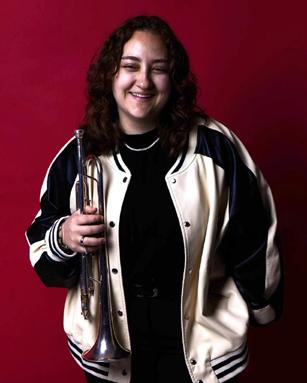
West Side Jazz Concerts at Johnny Jazz Park, Red Bank Sunday afternoons, 3 p.m.
AUG 04 Trumpeter Eddie Allen’s Tribute to Louis Armstrong
AUG 11 Saxophonist Wayne Escoffery
AUG 18 Drummer Winard Harper and Jeli Posse
AUG 25 Guitarist/Vocalist Chuck Lambert and Saxophonist Kenny Blake
Sweet Sounds Downtown, Westfield
Tuesday nights, Quimby St., 6 p.m.; Central Ave. and Foundation Park on South Ave., 7 p.m.
JUL 09 Saxophonist Bradford Hayes (Central Ave.)
JUL 23 Guitarist Joe Taino (Central Ave.)
JUL 30 Vocalist Carrie Jackson (Central Ave.)
JUL 30 Guitarist Glenn Alexander & Shadowland (Quimby St.)
AUG 06 Don Braden/Karl Latham Big Funk (Central Ave.)
AUG 13 Keyboardist Radam Schwartz (Central Ave.)
AUG 13 Funk/Rock/Latin/Jazz Group
Rusty Monks (Quimby St.)
AUG 20 R&B/Jazz Group Blue Vinyl (Central Ave.)
AUG 20 Jazz/Rock Group from NJ Workshop for the Arts (Foundation Park)
AUG 21 Tenor Saxophonist/Pianist Mitch Marcus (Central Ave.)
Montclair Jazz Festival Concerts
JUL 25 Jazz House Ambassadors directed by Alto Saxophonist Bruce Williams; Baritone Saxophonist Jason Marshall; Wallace Roney, Jr. (Wellmont Arts Plaza, 6-9 p.m.)
AUG 17 Uptown Showcase at Montclair State University, Kasser Theater: Jazz House Summer Workshop Student Ensembles (noon-5 p.m.); Julian Lee Quartet, Christian McBride & Friends (5:30-9 p.m. Donations encouraged).
AUG 25 Student feature (tba); Vocalist Vanessa Perea and the Robert Edwards Big Band (Wellmont Arts Plaza, 6-9 p.m.)
Did we miss you? If you are presenting free live jazz concerts in July or August in New Jersey, please email us at editor@njjs.org, and we’ll try to post something on njjs.org.
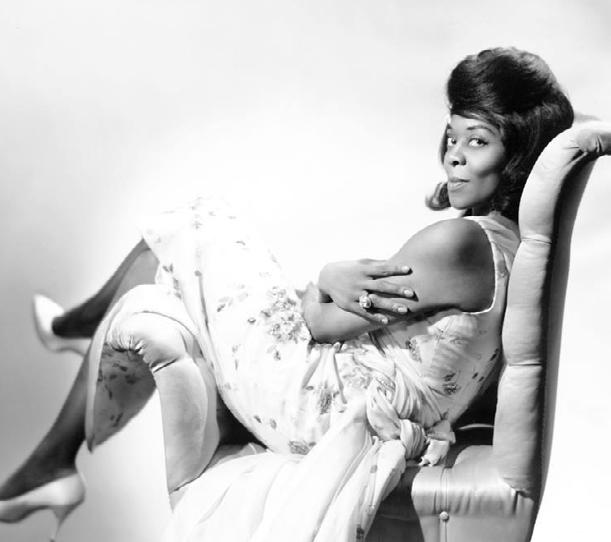
“There are All Sorts of Female Singers. Somehow, Dinah Washington Made Most Others Sound Like Little Girls”
She could take the melody in her hand, hold it like an egg, crack it open, fry it, let it sizzle, reconstruct it, put the egg back in the box and back in the refrigerator, and you would’ve still understood every single syllable.” That’s how Quincy Jones described Dinah Washington in his autobiography (Three Rivers Press: 2002).
Forever known as the “Queen of the Blues”, Dinah Washington started off as a gospel singer, following the lead of her very religious mother. Ruth Jones (Washington’s birth name) was born in 1924 in Tuscaloosa, AL, and
would have turned 100 on August 29 of this year. Sadly, she died at the age of 39 in 1963 from an unintentional overindulgence of prescription drugs for weight control and insomnia. Washington moved with her family from Alabama to Chicago’s South Side as a child. She sang and played the piano in her church choir and won an amateur talent contest in 1939 at the Regal Theater. That got her some gigs at various Chicago nightclubs, against her mother’s wishes, and she was discovered in 1942 by Lionel Hampton.
According to Nadine Cohodas,
author of Queen The Life and Music of Dinah Washington (Pantheon Books: 2004), many people take credit for introducing Washington to Hampton. “Joe Glaser (the agent best known as Louis Armstrong’s manager), the comedian Slappy White, and Hampton band member Snooky Young all claimed to have suggested that Hampton go to the Garrick (Stage Lounge) to hear Ruth sing. In a 1952 interview, Ruth herself recalled that (club operator) Joe Sherman brought Joe Glaser to hear her, and that the next night Glaser returned with Hampton.
“Whatever the impetus,” Cohodas continued, “one night in late December, after his show at the Regal, Hampton went the 50 blocks north to the Garrick ... At some point, Hamp-
ton asked her to sing ‘Sweet Georgia Brown’ ... By the time she got to ‘It’s been said she knocks ‘em dead when she lands in town’, Ruth had done just that. Hampton was sold.”
Shortly after that, she changed her stage name to Dinah Washington.”
While with Hampton, Washington recorded her first record, “Evil Gal Blues” on the Mercury label. Written by music critic Leonard Feather, it featured a sextet of bassist Vernon King, clarinetist Rudy Rutherford, drummer Fred Radcliffe, pianist Milt Buckner, tenor saxophonist Arnette Cobb, and trumpeter Joe Morris.
Washington stayed with Hampton until 1946 when she went out on her own as a solo singer. In the late ‘40s and throughout the 1950s, she
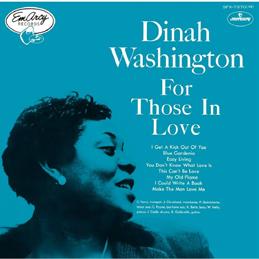
AllMusic said Washington was at “the peak of her (jazz) powers” on the 1955 EmArcy album, For Those in Love.
had several hit records that landed on the R&B charts. Her first record as a solo singer was Fats Waller’s “Ain’t Misbehavin’”, followed by such R&B hits as “Am I Asking Too Much” and “Baby Get Lost”. But her biggest hit, which propelled her onto the mass market was “What a Diff’rence
“ HER BIGGEST HIT WAS 'WHAT A DIFF'RENCE A DAY MAKES' . ”
a Day Makes”, originally written in Spanish by Mexican songwriter Maria Grever with English lyrics added by Stanley Adams. Her Mercury recording of it won a Grammy Award in 1959 for best R&B performance. By then, Washington had moved on from gospel and blues to make some jazz records, often with Jones. They included the 1955 EmArcy album, For Those in Love, and the 1957 EmArcy recording, The Swingin’ Miss D. AllMusic, reviewing For Those in Love, pointed out that Washington’s “straight jazz sessions were few and far between because of the mass popular and commercial appeal she had as a pop singer,” adding that “it’s thrilling to hear her at the peak of her powers backed by a small group that includes trumpeter Clark Terry and pianist Wynton Kelly. The session is also graced by Quincy Jones’ tidy arrangements. With such expert support, the singer’s powerful phrasing, diction,
and pitch-perfect intonation draw as much emotion and meaning possible out of her chosen material, including Billie-associated tunes like ‘Easy Living’ and ‘My Old Flame.’ Dinah Washington was first and foremost a musician--not a showboat. And part of her genius was that she could make her formidable presence actually underscore her own vulnerability, as in the lilting ‘Blue Gardenia’ and bluestinged ‘You Don’t Know What Love Is’.”
Washington made a triumphant appearance at the 1958 Newport Jazz Festival, resulting in the 1958 EmArcy album, Newport ‘58. She was also featured in the award-winning film of the festival, Jazz on a Summer’s Day.
In George T. Simon’s 1979 Doubleday book, The Best of the Music Makers, Dan Morgenstern, Jersey Jazz columnist and jazz historian, pointed out that, “There are all sorts of female singers. Somehow, Dinah Washington, strong, assertive, proud,

made most others sound like little girls ... Dinah Washington died four years younger than Bessie Smith and Billie Holiday, yet her legacy is that of an artist who fulfilled the promise of her talent. Her influence survived in the work of many singers, notably Nancy Wilson, and her records were still heard regularly on radio more than a decade after her death.”
A current vocalist often mentioned as someone heavily influenced
by Washington is Diane Schuur. In an email to Jersey Jazz, Schuur said, “I heard Dinah Washington as a very young girl. I didn’t know what was in store for me at the time, but I knew Ms. Washington had a quality in her voice and a vocal presentation that moved me deeply. I was an adolescent at the State School for the Blind, and my mother sent me an LP with ‘What a Difference A Day Makes’. I opened the package, and the smell of the vinyl is something I will never forget. Then the school played that beautiful record over the entire sound system. This soulful, elegant singer sent me a message then and there.”
Another vocalist influenced by Washington was the late Amy Winehouse. Tony Bennett’s 2011 Columbia album, Duets II The Great Performances, contained a duet of Bennett and Winehouse singing “Body and Soul”. Prior to the release of that
album, Bennett told the UK’s Independent that Winehouse was “very nervous to perform, but I said, ‘You know, it sounds like you’re influenced by Dinah Washington.’ She said, ‘How did you know that Dinah Washington is my goddess?’ She did some Dinah Washington licks, and, from that moment on, she just relaxed. And, it came out wonderful.”
In his Biographical Guide to the Great Jazz and Pop Singers (Pantheon Books: 2010), Will Friedwald wrote that Washington was “more than a pop singer, a blues singer, or a jazz singer; she’s one of the very few, very great vocalists who figure equally prominently in the development of all three of these genres of American music. She invests pop standards with a blues feeling, sings the blues with a jazzbased improvisational outlook, and can bring both a jazz and blues feeling into the most tepid of pop contexts.”

“It Will be an Eclectic Program ... After I Meet the Kids, I May be Inspired to Play Something They’re Working On”
BY SANFORD JOSEPHSON
The trombonist J.J. Johnson was born on January 22, 1924, and the celebration of his centennial birthday this year is particularly significant to trombonist/educator Wycliffe Gordon. Whether it’s for his own playing or when teaching his students, Johnson is, he said, “My go-to. His solos are so well thought out. You can learn the notes, but to learn the inflections you have to have a certain mastery of the trombone.”
Gordon, Director of Jazz Studies at Augusta (GA) University, will be the Artist-in-Residence at this
year’s William Paterson Summer Jazz Workshop for high school students being held from Monday, July 22-Saturday, July 27. In addition, he will be leading a quintet on Friday night, July 26, the last of five concerts in WPU’s Summer Jazz Room Series. His band for that concert will include multireedist Adrian Cunningham, bassist Jason Clotter, drummer Alvin Atkinson, Jr. and a pianist to be named later. “We will celebrate the 100th birthday of J.J. Johnson,” he said, “and the 125th birthday of Duke Ellington (April 29, 1899). It will be an eclec-
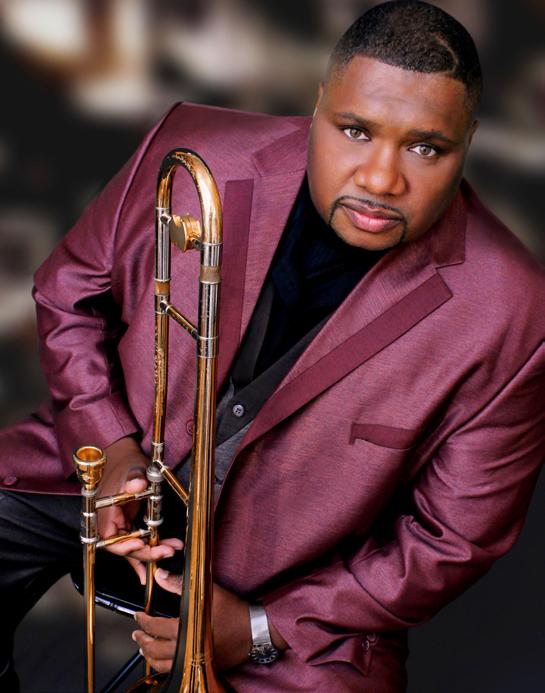
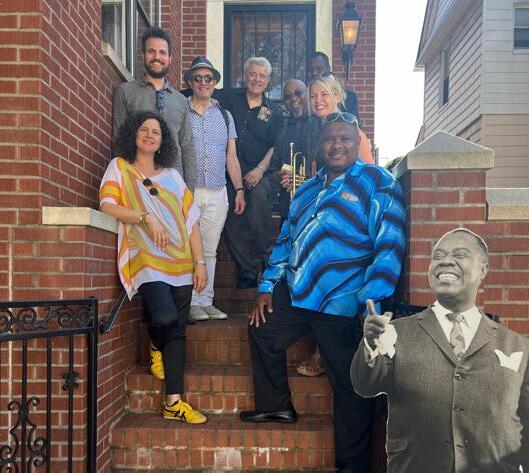
tic program. I’ll start out with something from the swing era and then some bebop, then maybe a ballad. That would kind of be my template, but, after I meet the kids, I may be inspired to play something they’re working on.” When you’re playing the music of Duke Ellington, he added, “You get a little of everything—great piano playing, trombone playing, trumpet playing, arranging, composing, just a litany of information.”
His advice to young musicians?
“First and foremost,” he said, “just be prepared for the performance. Dig into the meaning behind the songs or the composers. It informs you about how the music should be played, the purpose behind the music. Other than to play a good solo and play your parts well,” he emphasized, “the audience is always the most important thing.” And, if his trombone students want something to study, he said, “It’s always J.J. Johnson transcriptions.” Which ones? “’Laura’ or ‘Mysterio-
so’ or, for a ballad, ‘My Old Flame’.” According to Gordon, the trombone “has a wider range of voices than any other instrument.” In addition to J.J. Johnson, he learned from a broad variety of trombone masters such as Tricky Sam Nanton, Booty Wood, Al Grey, Jack Teagarden, Lawrence Brown, and Trummy Young.
Teagarden, he said, was “kind of like Pops (Louis Armstrong) was to the trumpet. The way he sang, the way he played. I love his mastery of the trombone and his flexibility. Lawrence Brown was known for his ability to play lead trombone and for the sweet tone that he played with. Trummy, he could play sweetly but he could also play raucously. There’s so much that each of them brought to the instrument. I learned something from all of those guys. I love all of them, but when I teach, my thing is, if you’re gonna be a jazz player, you have to understand jazz, but you can’t play jazz if you can’t
play your instrument. You have to get the pedagogical thing together.”
Many of Gordon’s former trombone students are at the forefront of today’s jazz scene. Among them: Marshall Gilkes, Ryan Keberle, Michael Dease, and Nick Finzer. “I don’t call them students,” he said, ‘because they had it together before they came to me.” All four studied with Gordon at Juilliard.
Gordon met Finzer when he was still a high school student in Rochester, NY, and Finzer remembers that well.
“

at the Eastman School of Music, he actually wrote a series of commissions (funded by a Rochester organization called The Commission Project) for me for both small group and big band. Wycliffe has always been a huge inspiration to me. He’s an incredible musician, and I feel very fortunate for his mentorship over the years.”
“When I was in high school,” he told me in an email, “I was very fortunate that Wycliffe Gordon used to come through Rochester from time to time to perform. There was one occasion when he invited me to grab my horn out of the car and play a little bit in the dressing room with him during his set break. He was so kind and encouraging. It really changed the trajectory of my life. While I was a college student
ber 2 after 11 weeks on the Top 50 list. The recording, Finzer said, “has been a really special project for me. It’s an honor to be able to celebrate one of our true trombone heroes, especially with musicians J.J. hired for his band—(bassist) Rufus Reid, (pianist) Renee Rosnes, and (drummer) Lewis Nash.” (See review on page 34).
Michael Dease shared with me a recent Facebook tribute he posted about Gordon. “He gave me one of my first trombone lessons on New Year’s Eve in 2000,” Dease recalled. “From day one of our lessons and friendship, he encouraged me to be authentic, work JAZZ
The Guardian’s Dave Gelly: “It’s the musicianship that does the trick. The parts may be simple but the playing is world-class ...”
Finzer also shares Gordon’s appreciation for J.J Johnson, who died in 2001 at the age of 77. Finzer’s Outside in Music album, Legacy: A Centennial Celebration of J.J. Johnson, reached Number 1 on the Jazz Week charts, and, at presstime, was Num-
hard, and tell my story. He challenged me to dedicate myself to music as deeply as he does and to challenge him as well. You’ve heard the proverb, ‘It takes a village.’ The Mayor of my village is Wycliffe Gordon. I’m so proud to sound (on a good day) even a tiny bit like him. “
Finzer and Dease played with Gordon in early June at the International Trombone Festival in Fort Worth, Texas. Dease, who is Professor of Jazz Trombone at Michigan State University, brought a group of his students to the festival. According to Gordon, “They sounded great. It’s rare to see so many students who play that well. They have not only mastered the trombone, but they have also mastered improvisation. They went on the night before we were featured. These kids are ready to hit the road.”
Just as Gordon has mentored so many young trombonists, he was inspired and encouraged by trumpeter Wynton Marsalis nearly 30 years ago.
In 1987, when Gordon was a sophomore at Florida A&M University, Marsalis came to the school’s jazz band rehearsal, “and we got a chance to play for him. He heard us play as a group and individually.” Shortly after that,
Gordon received a phone call from Marcus Roberts, the pianist in Marsalis’ septet, inviting him to play with the band at the Caravan of Dreams in Fort Worth. “He was trying me out,” Gordon said. On June 6, 1989, Gordon was invited again to play with Marsalis, at the Spoleto Festival in Charleston, SC. “After that, he asked me, ‘Do you want to play on the road for awhile?’ I thought about it for all of 10 seconds.” Gordon joined the Wynton Marsalis Septet and subsequently became a member of the Jazz at Lincoln Center Orchestra.
Gordon has been named the Jazz Journalists Association Trombonist of the Year 13 times, has finished first in DownBeat’s Critics’ Poll six times, and has recorded 21 albums as a leader.
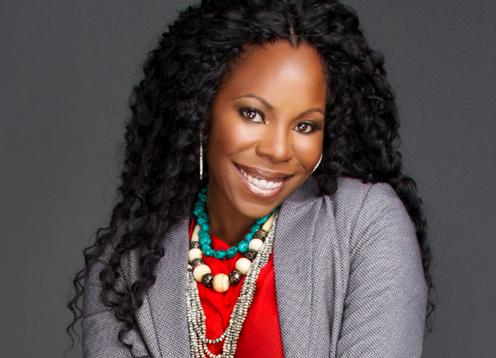
Following is the complete schedule for the William Paterson Summer Jazz Room Series. All evening concerts, at the Shea Center for the Performing Arts, begin at 7:30 p.m.
MONDAY, JUL 22 » Pianist/vocalist Kelly Green and her Seems Quartet
TUESDAY, JUL 23 » Trumpeter/vocalist Benny Benack with the Big Beat Big Band
WEDNESDAY, JUL 24 » Trumpeter Brian Lynch and Spheres of Influence
THURSDAY, JUL 25 » Alto saxophonist Tia Fuller leading her Trio
FRIDAY, JUL 26 » Wycliffe Gordon and Friends
SATURDAY, JUL 27 » Student Concert (free), 1 p.m.
One of those albums was the 2012 Chesky Records recording, Dreams of New Orleans. Reviewing it, The Guardian’s Dave Gelly pointed out that, “ Venerable New Orleans favourites such as ‘Panama’ and ‘Tiger Rag’ have been played so much over the years, often indifferently, that you might think they’d been done to death. Well, here comes trombonist Wycliffe Gordon, for many years right hand man to Wynton Marsalis, to prove otherwise. With his broad, warm tone and a handpicked band, he recasts 15 of them and brings them back to life. Nothing radical, just a touch here and a trim there. It’s the musicianship that does the trick. The parts may be simple but the playing is world-class ...”
Before the William Paterson performance, Gordon will be leading his quintet at Birdland for five days (July 16-20). On June 15, the day after our interview, he led an all-star band at the Louis Armstrong
House’s Juneteenth concert. The band included: trumpeter/vocalist Bria Skonberg, clarinetist/tenor saxophonist Anat Cohen, tuba player
David Ostwald, multi-instrumentalist Vince Giordano, drummer Alvin Atkinson, Jr., pianist Ehud Asherie, bassist Jason Clotter, and vocalist Svetlana Shmulyian. In a Facebook post, Ricky Riccardi, LAH Director of Research Collections, described Gordon as “the closest thing to the spirit of Pops imaginable.” In an email to me, Riccardi listed some of the Armstrong favorites played that afternoon: “’When It’s Sleepy Time Down South’, ‘Indiana’, ‘Black and Blue’ (sung by Wycliffe), and ‘On the Sunny Side of the Street’ (sung by Bria).”
: The Shea Center for the Arts is located at 300 Pompton Road on the WPU campus in Wayne, NJ. For information and tickets, log onto wppresents.org or call (973) 720-2371.

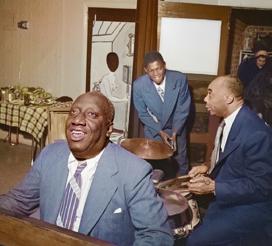








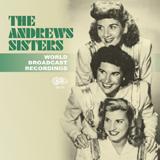


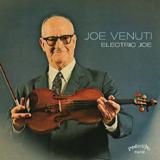
“It was Fun to Take What I had Learned from the Pop and Rock World and Move it into Jazz.”
BY JAY SWEET

Like a fine Cabernet Sauvignon, Mindi Adair’s music is deep, layered, nuanced, earthy, and can be appreciated by both demanding critics and casual listeners. Comparing Adair’s music to fine wine is no coincidence; wine has become a significant part of her life and livelihood. The Grammy-nominated saxophonist and singer will blend her jazz stylings with a love of wine on August 17 at the Union County Performing Arts Center in Rahway, NJ.
“My husband,” she explained, “is from Jefferson Twp., New Jersey, so I’m excited to play there. We’ll do a wine tasting, which is my husband Eric Guerra’s calling. It’s been his job for 25 years, running wineries. And now he runs our company, WineandJazz.com. So, bringing my Jersey boy back to Jersey will be great, and we’re bringing my full band. He’s the wine, I’m the jazz, so we can have our
place and be together in what we love.
“We now travel the world together,” she continued. “We’re going to do this pre-show wine and jazz tasting. We make eight different wines a year that are all music-centric with the artwork, and he has winemakers make us wine that no one else gets. I play music to pair with each tasting. So it’s all about pairing wine and music, and since that’s our real lives, we hope that other people will like doing that as much as we do.”
After playing with some of the biggest names in the world, Abair has earned the right to enjoy a glass of vino from time to time while creating the music she loves. Her musical journey began in St. Petersburg, FL.
“My dad plays saxophone, keyboards, and bass,” she said. “I grew up on the road with his band, The Entertainers, and we didn’t have a house until I was five when the band broke up. So, we
just traveled. Every childhood picture shows me packing the band truck or at a motel somewhere. It was a wild way to grow up, and I was basically raised by the awesome guys in the band.
“My grandmother was an opera singer with this beautiful coloratura soprano voice. She was everything stereotypically that you think of as an opera singer—just a big woman with a big personality. She was awesome. She’d come over and play Beethoven, then play an aria and sing it with me. My dad was off playing rock
“
and roll, and I’d come home from school to find them recording drums in my closet. It was just nuttiness.
“I was a total pop kid. I listened to the radio and watched MTV, so it was simple who my influences were. I thought Heart was amazing. I loved Tina Turner and Springsteen.
Clarence Clemons inspired me, and I was a huge fan and knew every solo. The first night I got to play his parts with Max Weinberg and then with Bruce Springsteen was something I never thought would happen.
ME, AND I WAS A HUGE FAN AND KNEW EVERY SOLO . ”

I was listening to a lot of rock, and I loved the energy and emotion of it.”
When Abair was in high school, her father brought her to a David Sanborn concert. “The light bulb just went off,” she said. “David’s band was like a rock band, and David was the lead singer, but instead of using his voice, he played a saxophone. That made all the sense in the world because I couldn’t sing like Tina Turner, but on a saxophone, I could scream like Tina Turner or whisper. It was fun to
take what I had learned from the pop and rock world and move it into jazz.”
At the University of North Florida and then the Berklee College of Music, Abair remembers people asking her, “‘Do you listen to traditional or contemporary jazz?’ I didn’t even know what any of that meant. So, I started listening to the older (traditional) players like Miles Davis, Cannonball Adderley, Wayne Shorter, Michael Brecker, and John Coltrane, and just thinking, wow! There’s
this whole other world. But I came into it backward from most people. I remember having these conversations where people told me, ‘You’re selling out if you’re not playing traditional jazz.’ I thought it through and realized I would be selling out if I played traditional jazz because contemporary jazz was the music that moved me and that I wanted to play.”
Following college, Abair moved to Los Angeles. “Some of us Berklee students,” she recalled, “got a call from Barry Manilow who said, ‘I need a whole new band. I know you’re at Berklee, and you know the cats—put a band of the cats together and come audition for me.’ So we flew to L.A. We rehearsed, and we did the audition. We were so wrong for him. I got drummer Abraham Laboriel Jr., who had his whole head shaved with a little ponytail on top. I had the sides of my head shaved with hair down to

“When I got to Los Angeles, I realWhen Abair’s father took her to see David Sanborn “The light bulb just went off. David’s band was just like a rock band, but instead of using his voice, he played the saxophone.”
my butt. The percussionist looked like Tarzan. We were a bunch of misfits for someone like Barry Manilow. We were all good musicians, but we did not get the gig. But I was walking around L.A. and thought this is the place to be. So I packed up everything in my little Civic and drove across the country.
ized it has amazing saxophone players. They don’t need you. So, I had to find my way, start my band, and just go for it. I would play anywhere they let me. I played on the steps of the Capitol building, in the men’s underwear department at Macy’s, in hotel lobbies, and on the street down by the beach, just putting out my case and playing. One day, (keyboardist) Bobby Lyle walked by and literally stuck around and said, ‘You’re really good. Would you want to play on my new record and go on the road with me in my band?’ His band was just amazing! It was Alfonso Johnson on bass and Al McKay from Earth, Wind & Fire on guitar. These guys took me under their wing and showed me how to be a pro. I toured everywhere with them. Bobby Lyle took me on the road for probably five or six years. Then I went out with Jonathan Butler and Teena Marie.”
From these experiences, Abair be-
gan playing with mega-stadium acts.
“The Backstreet Boys called, and I saw the world like a rock star for a couple of years, with pink, blue, and purple hair. It was amazing. Then, I got to work with Adam Sandler. Waddy Wachtel was his music director, and he’s incredible. They wanted someone who could sing and play sax, and I got the job. Those things happened out of nowhere while I was trying to be a solo artist. Finally, when I was on the road with Duran Duran for their comeback tour to America, I told John Taylor (Duran Duran’s bass guitarist), ‘I got to go be me and give my solo career a real shot,’ and he understood.”
Abair’s solo career has been impressive, and she has used her many famous contacts to enhance her work.
“I’ve had a great career in contemporary jazz, and by the time I made my record Wild Heart (Heads Up Records, 2014), I had this very cool
contemporary jazz career, but I was moonlighting all the time, playing with blues and rock stars.. At a certain point, I thought, okay, I have to reach out to my friends I play for and ask them for help to bring it into my world. So that’s what I did. I went
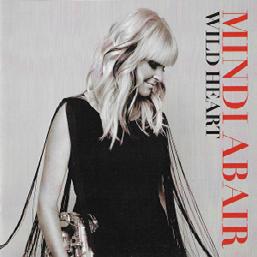
Abair’s 2014 album, Wild Heart, according to AllMusic’s Thom Jurek, had “gritty, raucous spirit, and exceptional creative imagination.”
to Greg Allman’s house for three days, and we got this beautiful song out. The same thing happened with Max Weinberg—we had become such good friends. I have Joe Perry and Booker T on my record, who I didn’t know but was a fan of. We’ve written three songs together. I also asked Keb’ Mo’ because we had been musical partners and Trombone Shorty because we ran in the same circles.”
When Wild Heart was released, Jazz Weekly’s George W. Harris wrote: “Abair’s sax growls, grunts, and grinds like it’s a smoky joint in Lafayette, Louisiana, with more gristle than a T-Bone steak at The Pantry.” AllMusic’s Thom Jurek added that the album had “gritty, raucous spirit, and exceptional creative imagination.”
While Abair’s primary focus continues to be her solo projects, she has not abandoned being the saxophonist to the stars. “The bands that I’ve toured
with of late, it’s like a summer vacation. Like when Steven Tyler asked me to go on the road with Aerosmith, I’ll do those things here and there, but you know, it’s my band all the time.”
Abair’s current tour involves traveling worldwide, and she shows no signs of slowing down. “We are doing a bunch of tour dates this year, and it’s been all over the map. I just finished opening for Kool and the Gang a couple of nights ago, and that was awesome. We’re doing Summerfest, a big festival, and playing the
Catalina Island Jazz Festival. I continue to do Mindi Abair’s Wine and Jazz Adventures. We finished two in Napa, and we’re doing two weeks of them in Tuscany. My husband will curate wineries and Michelin-starred restaurants, and I’ll play concerts daily.” There is also a Christmas tour and a New Year’s Eve show in San Diego. “Most of the material is the jazz songs I have recorded over the last 22 years, and then we’ll throw in a couple of cool covers that I love. I do a different set list every night.”
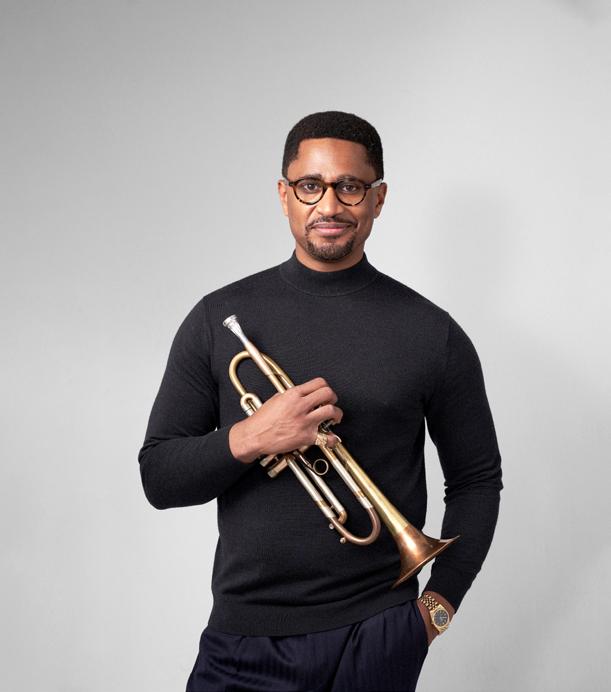
‘a
BY SANFORD JOSEPHSON
Sometime this fall, trumpeter Bruce Harris and pianist Ehud Asherie will be releasing an album in tribute to the late pianist and educator Barry Harris. “I had always been a fan of listening to Barry Harris’ records,” Bruce Harris told me, “but, in 2009, when I met Barry Harris—a master player and groundbreaking master teacher—I was astounded by how much he knew about the music in depth and how he could explain it. We also connected. He
knew that I knew music, that I was familiar with Charlie Parker. So, we kind of took a liking to each other.
“Also,” he continued, “it didn’t hurt that my last name was Harris. We had great chemistry. He just would always call me the prodigal son, or his grandson, really. It was special for me to have that relationship with him because a lot of the elders in my family had passed at young ages. So, he was literally like a grandpa.”
The first meeting between Bruce
and Barry Harris took place 15 years ago when Bruce was 29 years old and already a young professional. His trumpet mentors were Wynton Marsalis and Jon Faddis. Harris studied under Faddis at the SUNY Purchase Conservatory of Music. “I’ve known Jon since I was about 17 years old,” he said. “He has been a mentor to me consistently since then.”
Harris’ first contact with Marsalis was in 1996 when he was part of the jazz band at the Adlai E. Stevenson High School in the Bronx. The Steven-
son jazz band finished third in the inaugural Jazz at Lincoln Center Essentially Ellington competition. “He honestly didn’t become fully aware of me until I was around 30 when I performed a week at Dizzy’s during the holiday season,” Harris added. “I did the late show after his set. That was kind of like when we formally connected.”
In an October 2013 interview with Ebony Magazine, Marsalis was asked to name five young jazz players “that everyone should know.” One of them was, “Bruce Harris, he’s a
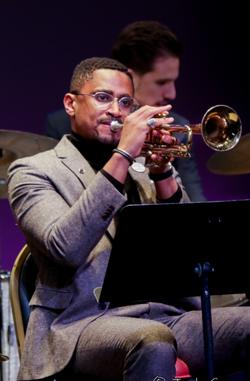
Bruce Harris playing with Mariel Bildsten’s Septet at the Morris Museum in January 2020
“ I’VE KNOWN
JON (FADDIS) SINCE I WAS ABOUT 17 YEARS OLD . ”
trumpet player.” (The others were bassist Russell Hall, alto saxophonist Patrick Bartley, pianist Chris Pattishall, and drummer Joe Saylor).
On July 27, Harris will lead his sextet, Pretty for the People, at the Caramoor Jazz Festival in Katonah, NY. The band, known for mixing jazz with rhythm and blues, will feature vocalist Sage Myers, alto
saxophonist Irwin Hall, keyboardists Julius Rodriguez and Brendan Skidmore, and drummer Joe Blazz.
On August 10, Harris will be performing the early show (5:30 p.m.) at New York’s Birdland. At presstime, he hadn’t put his band together yet or decided what the show’s theme will be. “Sometimes, I just like to be where I am in that moment,” he explained.
Two Dizzy’s Club engagements in late August and early September, however, have specific programs. From August 25-27 he will lead a sextet in a presentation called “Byrd in Flight”, a tribute “to the great master trumpet player, Donald Byrd and his great band from the bebop era, Blackbyrds.” The band will include tenor saxophonist Chris Lewis, baritone saxophonist Jason Marshall, pianist Tyler Bullock, bassist Jayla Chee, and drummer Chris Beck. (Bullock was the February 2024 Jersey Jazz Rising Star).
The weekend of August 30- September 1, Harris will co-host a centennial birthday tribute to trumpeter Kenny Dorham at Dizzy’s with fellow trumpet player Joe Magnarelli. Those performances will also feature several guest trumpeters to be named later. Dorham, incidentally, recorded a now out-of-print album with Barry Harris in 1964 on the RLR Records label. Called Kenny Dorham-Barry Harris Quartet—New York 1964, it contained such tunes as Dorham’s “Scandia Skies”, Charlie Parker’s “Confirmation”, and Thelonius Monk’s “Round Midnight”.
Bruce Harris’ latest album was the 2022 Cellar Live recording, The Lighting of the Lamps, a joint effort with tenor saxophonist Grant Stewart. DownBeat’s Scott Yanow described it as “the type of session that bebop fans love.” Though released in 2022, the album was recorded in November 2021, and Yanow wrote that, “One
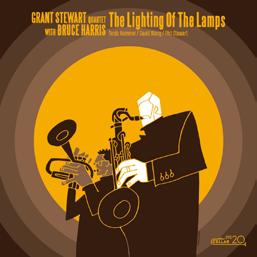
DownBeat called The Lighting of the Lamps “the type of session that bebop fans love.”
can sense the feeling of happiness that the musicians must have had in getting to finally play live with others.”
Selections included Thad Jones’ “Bitty Ditty”, Benny Golson’s “Out of the Past”, and the Frank Sinatra standard, “I’m a Fool to Want You”. That album, Harris recalled, was recorded at the celebrated Rudy Van Gelder Studio
in Englewood Cliffs, NJ, “so, it was uplifting to be in that space, based on the history. So much music I listen to was made in that place. It’s always a touching moment to be there.”
When Harris released his debut album, Beginnings, on the Posi-Tone label in 2017, AllAboutJazz’s David
A. Orthmann wrote that the recording, “sounds as if it’s guided by an old hand instead of someone relatively new to the demanding art of leading a band. The debut recording of trumpeter Bruce Harris captures a coherent, homogeneous group sound, while utilizing several different combinations of instruments. Harris ties together material ranging from Harold Arlen to Bud Powell to Prince, as well as his own originals, and judiciously employs the assorted voices of several soloists who effectively express themselves in only a chorus or two.”
Harris has also been exploring
West African music. “I’ve been experimenting with that style of music,” he said. “I recently traveled to West Africa and was profoundly influenced by that visit. For the past two years, I’ve listened to as much Fela Kuti and Ebo Taylor as I do to Charlie Parker. I really have a deep love and appreciation for West African music.”
Kuti, a Nigerian keyboardist and vocalist, who died in August 1997, created a style of music called Afro-bet, which combined American blues, jazz, and funk with the music of his native land. Taylor is a Ghanaian guitarist, composer/arranger, and bandleader. In the early ‘60s, he took his group, the Black Star Highlife Band, to London and collaborated with Kuti as well as other African musicians who were in Great Britain at the time. His work has become very popular with hip-hop producers, and, in 2015 at the Stanbic Jazz Festival in Zambia, he performed
with American guitarist Earl Klugh. Throughout his career, Harris has been deeply involved in jazz education. While still at Purchase he began teaching private lessons as well as briefly serving on the faculty. He has taught at the Berklee College of Music, The New School, and at “tons of workshops at Jazz at Lincoln Center.” He is also Program Director of the Louis Armstrong House. When asked about young rising stars on trumpet, Harris mentioned a student he taught at the New School, Kal Ferretti, who played on trumpeter Grace Fox’s 2022 debut self-produced big band album, Eleven O’ Seven. (Fox was a 2023 New Jersey Jazz Society scholarship winner, and her big band will be appearing August 8 in Red Bank, NJ. See page 09). Ferretti has performed at Birdland and Dizzy’s, participated in Essentially Ellington when attending LaGuardia High School, and was a member of
the Lincoln Center Youth Orchestra.
In one of the last New Jersey concerts before the pandemic, Harris played with trombonist Mariel Bildsten’s septet in January 2020—a celebration of music by Count Basie and Duke Ellington at the Morris Museum’s Bickford Theatre. One highlight of that concert was Harris’ solos on “Boy Meets Horn’, co-written by Ellington and trumpeter Rex Stewart. He was the veteran of that young group, which also included tenor saxophonist Ruben Fox, alto saxophonist Sarah Hanahan, pianist Sean Mason, bassist Marty Jaffe, and drummer Evan Sherman.
From 2011 to 2016, Harris played with the Count Basie Orchestra and that experience, he said, “was an honor, to be a part of that lineage. There were so many great trumpet players— from Thad Jones to Johnny Coles. Most of the world that I’ve seen is a result of traveling with that band.”

AUGUST 17 TH
Pre-show Wine event 3:30
Matinee Show 5pm | Evening Show 8pm
“It Was One of the Tougher Solos to Learn. Paul Gonsalves Lit it Up.”
enor saxophonist Paul Gonsalves’ 27-chorus solo on “Diminuendo and Crescendo in Blue” with the Duke Ellington Orchestra at the 1956 Newport Jazz Festival is etched in jazz history. It energized the Newport audience and rejuvenated Ellington’s band. So, the prospect of recreating that moment at Jazz at Lincoln Center’s 2024 Essentially Ellington competition had to be daunting to 18-year-old Newark Academy tenor saxophonist Ani Chakravarthy. But he took it all in stride.
“It was one of the tougher solos to learn,” he said. “Paul Gonsalves lit it up. I first just went through all the recordings, chorus by chorus, trying to transcribe the whole thing. I didn’t get through all 27 choruses, but it helped me get the ideas in my head for when I was going to do the solos myself.
“After I got the underlying language,” he continued, “I tried to listen to other musicians. Mr. Tolentino (Newark Academy Jazz Director Julius Tolentino) told me that I ought to
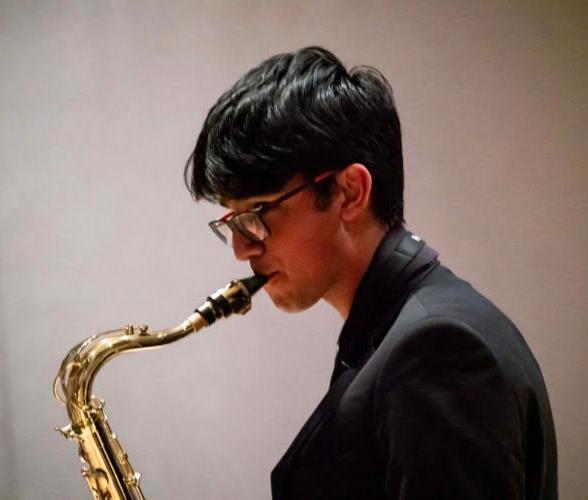

think about having a tone that resembles Paul Gonsalves but that I could still put in some lines from other people. So, I tried to learn some Lester Young sounding lines. I also listened to a lot of Dexter Gordon and Sonny Stitt.”
As has been previously reported on njjs.org, Newark Academy won this year’s Essentially Ellington, with its performances of “Diminuendo and Crescendo in Blue” along with “Golden Cress” and “Boy Meets Horn”. And, Chakravarthy was recognized as an Outstanding Tenor Saxophone.
The Montclair resident joined the Newark Academy jazz band in sixth grade. Music, he said, “is very important in Indian culture. So, I’ve been dealing with music since kindergarten or first grade. I started with piano. I did classical. I liked classical, but I thought it was a little bit constraining at times. I was only doing what other people had written. There wasn’t any place I could put my personality into it.”
Tolentino described Chakravarthy as “one of our homegrown Newark Academy musicians. He’s been taking lessons with me since middle school and has been inspired by several of our past soloists. Now, he’s inspired the future soloists, of which we have several ready to take on that role for years to come. He has a solid grasp of the language and style of the tenor saxophone lineage.”
In addition to the Newark Academy band, Chakravarthy attended the Jazz House Kids Summer Workshop, calling the program “one of the greater workshops to help you become a better musician. They really help you with every aspect of your playing— your soloing ability, playing in a big band. That’s a big factor in how I’ve grown.” He credits tenor saxophonist Mike Lee with “teaching me technique. His method for teaching technique has been very important.”
In the fall, Chakravarthy will be

joining his NA classmate, drummer Ben Schwartz, at Columbia University (See interview with Schwartz in the June issue of Jersey Jazz). Columbia’s location in New York City was an important part of Chakravarthy’s decision to go there. “I’ve always really loved the city and its migrant culture,” he said. “I want to keep music as an important part of my education, but I’m not necessarily majoring in it. New York City has the perfect atmosphere for what I’m searching for. There’s an opportunity to play within Columbia with the very talented jazz ensemble,
but there’s also an opportunity for me to go and see all these classic places such as Smalls and play at these awesome jazz locations. It will help me grow as a musician and as a listener, too.” His favorite current saxophonists are Kamasi Washington and Joshua Redman. Their music, he said, “is very unique. I just like the vibe of it.”
This summer, he is working at Tolentino’s workshop. “I worked there last year and was a student before that,” he said. “Mr. T. has helped me grow so much as a musician and as a person.”—SANFORD JOSEPHSON

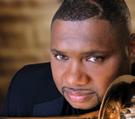
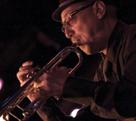


Monday, July 22 • 7:30 p.m.
The Kelly Green Seems Quartet
Tuesday, July 23 • 7:30 p.m.
Benny Benack with the
Big Beat Big Band (and that’s a lot of B’s!)
Wednesday, July 24 • 7:30 p.m.
Brian Lynch and Spheres of Influence
Thursday, July 25 • 7:30 p.m.
The Tia Fuller Trio
Friday, July 26 • 7:30 p.m.
Wycliffe Gordon and Friends

BY BILL CROW

When I was in the 2nd Army band in 1948, we toured to Cincinnati. I went over to Covington, KY, and heard a very good pianist playing solo in a gambling joint. I went back to my hotel in Cincinnati and got my baritone horn and sat in with the pianist. When someone asked for “Ace in the Hole,” I knew it from an Anita O’Day record I had at home. I played it, and I got a lot of tips from the gamblers. It was their lucky song. They threw the money in the bell of my horn. Those were my first tips!
Mark Morris posted a sign on Facebook that he found in Florida. It reads: Hamburger helper only works if hamburger is ready to accept that it needs help.
Bill Crow is a freelance musician and writer. His books include Jazz Anecdotes, Jazz Anecdotes: Second Time Around, and From Birdland to Broadway. This column is reprinted with permission from Allegro , the monthly magazine of AFM Local 802.
Jack Segal, a songwriter friend of mine, once told me that when he married his first wife, Lillian, they took a plane to Maryland, where it was possible to get licensed and married on the same day. When they returned to New York, Lillian called her mother. “Ma, Jack and I just got married. We flew down to Maryland and got married there.” Her mother replied, “You flew! Why didn’t you tell me? I would have worried!”
The late trumpet player Johnny Carisi now has a good reputation as having been a fine jazz composer, but during his lifetime he often had difficulty making enough money to pay his bills. He told me that a friend of his had a connection to Sammy Kaye and had set up an interview with the bandleader so that John could show him some of his arrangements. The Kaye band played pop dance music,
without a trace of jazz. John said he bought a few Kaye records and tried writing that kind of music. He said, “I discovered the formula. If I wrote four bars that I liked, I would erase them.”
Armed with three or four arrangement that he thought might fill the bill, John went to the meeting that his friend had set up with Sammy Kaye, and he told me that the encounter was cordial, but didn’t produce any offers of work. And he committed a faux pas as he left. Sammy Kaye was wearing a monogrammed shirt, and the large K on Kaye’s chest may have been what caused John to say, as he shook hands when they parted, “Thanks very much, Mister Kyser.” He had subconsciously come up with the name of one of Kaye’s worst competitors, Kay Kyser.
Kalman Gancsos posted this on Facebook: I was just a beginning bassist working a club in
“
Youngstown, Ohio. As I was tuning my bass to the piano at 440, I kept hearing a hum at around 436 or so from above and behind me. There was a raised dining area just back of the stage separated by a railing. I turned around to try to see where the hum was coming from, and an older guy, sitting with his wife sat there smiling. He was the bassist on the Arthur Godfrey show, on vacation, having a little fun with a budding bassist.
Ken Berger sent me this one: On a busy afternoon back in the 1970s, Burt Collins, Joe Shepley, and I decided to stop at the Carnegie Deli for lunch between dates. The place was packed, but we managed to squeeze into three seats at the end of a large table. Soon after we sat down, a cus-
tomer returning from the ladies’ room found her path blocked by Joe’s chair, which was protruding into the aisle. She tapped Joe on the shoulder and politely asked, “Can you please push in a little?” She seemed a bit nonplussed when Joe replied, “Why, am I flat?”
John Altman posted this on Facebook: A few bon mots from Al Cohn, my favorite house guest: On hearing that Stan Getz was playing in London, Al said, “Let’s book front row seats and see how long until he gets rattled!”
On being asked whether Cats, the musical, had any chance on Broadway, he said, “Only if they change it to K-AT-Z!” On learning that I had watched the two-hour documentary on the notoriously egocentric Artie Shaw, Al asked,”Did he mention himself at all?”
Many years ago, I was playing a party at the Sherry Nether land Hotel with a little band that Al Cohn had put together—Joe Wilder on trumpet, Bernie Leigh ton on piano, and Joe Cocuzzo on drums. As we were playing, band leader Elliot Lawrence and his wife danced by. At the end of the tune, Elliot came over to the band and said, “Guys, I don’t usually dance, but this band is swinging so much that I just had to!” I laughed and said, “You know, the music most club date bands play today is a style that started out as jazz, back in the day. It got frozen into that two-beat style that became the standard ‘business man’s bounce.’ But most of those people are dead now, so I think it’s okay for us to go into four!”


for more Sandy info
BY JOE LANG
Swingin’ Uptown (self-produced) is the seventh album from the Eyal Vilner Big Band. On this outing, Vilner leads a nonet rather than his usual 16-piece aggregation. In addition to leading the band, Vilner performs on alto sax, clarinet and flute, and arranged all 16 charts on the album. No matter the size of his band, you can be sure that it will be swinging all the way. The program includes six Vilner originals and his clever approaches to 10 tunes from the jazz canon. On four tracks, “Tell Me Pretty Baby,” “Is You Is or Is You Ain’t,” “I Love the Rhythm in a Riff”, and “Swing Brother Swing,” Imani Rousselle adds her vocalizing to the proceedings. Vilner gets a big sound from the nine players, and they are committed to making things perfect for those inclined to swing dancing. The last track. “Afternoon at Smalls,” is taken from a
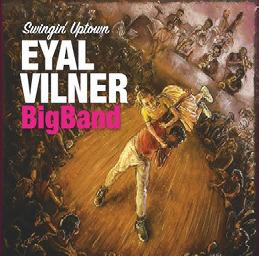
previous recording session by the full big band, giving the listener a taste for what they can find on prior Vilner albums. Whether you like to cut a rug or simply tap your toes, this is a recording that will suit you just fine. eyalvilner.com
Ray Brown had a successful career as a trumpeter and arranger for Stan Kenton, Bill Watrous, and Bill Ber-
ry, the Capp-Pierce Juggernaut Big Band and the Full Faith and Credit Big Band. He formed his own big band, Ray Brown’s Great Big Band, in 1994. The band gigged around the Bay Area and recorded two albums before Brown disbanded it in 2016. In 2022, he reformed the band to record I Could Write a Book (Summit – 821), a two-disc set containing 21 of his charts. Most of the selections are standards, including the closing five tracks of Christmas songs. Brown’s exciting charts are superb and demanding. The players are well suited to the task of bringing the music to life. The ensemble playing is tight with sparkling solo work sprinkled throughout. It is fortunate for modern big band enthusiasts that Brown brought these players together once more to add this wonderful exclamation point to a terrific group. summitrecords.com
Alto saxophonist Jon De Lucia was taken by the octet recordings of Lee Konitz and formed an octet to play this music. His enthusiasm for the music created for the octet format led him to the Dave Brubeck octet recordings of the late 1940s. He was able to find what was available of the charts in the Brubeck archives at Mills College, where Brubeck had been a graduate student. Most of the arrangements were by tenor saxophonist Dave Van Kriedt, with others by Brubeck and clarinetist Bill Smith. The charts were a mess, but De Lucia was able to recreate them and add some new intros and backgrounds. He assembled a crew including himself on alto sax, Scott Robinson on tenor sax, Brandon Lee on trumpet, Rebecca Patterson on trombone, Jay Rattman on clarinet and baritone sax, Glenn Zaleski on piano, Daniel Duke on bass ,and Keith
Balla on drums to record The Brubeck Octet Project (Musaeum Clausum Recordings – 003). There are 12 tunes on the program, “Love Walked In,” “Let’s Fall in Love,” “September in the Rain,” “I Hear a Rhapsody,” “The Way You Look Tonight,” “What Is This Thing Called Love” and “Love Me or Leave Me,’ plus two originals each by Brubeck and Van Kriedt and one by Smith. De Lucia and his band have brought a scintillating freshness to this 70-year-old material, giving his diligent restoration efforts a positive result. jondelucia.com
Clarinetist/tenor saxophonist Ken Peplowski has been dealing with some serious health issues in recent years, but he has continued to produce the kind of superior sounds that have been the hallmark of his career, despite the challenges that he has faced. Live at Mezzrow (Cellar Mu-
sic – 007) finds him in the excellent company of pianist Ted Rosenthal, bassist Martin Wind, and drummer Willie Jones III for a 10-tune program of great standards, including “Prisoner of Love,” “Beautiful Love,” “All the Things You Are,” “Like Young,” and “The Shadow of Your Smile”. Peplowski is always creative in his playing no matter the tempo, and his sound is a sheer delight to hear on both of his
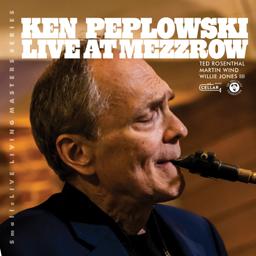
instruments. Having the three bandmates on this gig is an added benefit for they are among the best on their respective instruments. Those who were present in the intimate setting that is Mezzrow were treated to an evening of superior jazz, and now a broader audience can enjoy some of the music they heard. cellarlive.com
Melody is at the heart of each selection on My Shining Hour (Zoho – 202403) by baritone saxophonist Paul Kendall. Kendall has been concentrating on tenor sax in recent years but reverted to baritone which he had played earlier in his career. Pianist George Gund, bassist Roy Cumming, and drummer Rudy Petschauer support him on straight ahead renderings of 14 pop and jazz standards. The tunes include “You Stepped Out of a Dream,” “My Shining Hour,” “Joy Spring,” “If You Could See Me Now,”
“Confirmation,” “Tangerine” and “It Could Happen to You.” Kendall is a fluid player who respects the tunes by clearly stating each of them before letting his imagination take him to the land of improvisation. Gund takes nice advantage of the solo space given to him. Cumming and Petschauer are solid in support. All in all, My Shining Hour will give you an hour of shining music. zohomusic.com
Multireedist Brian Landrus has created a fascinating approach to the music of Duke Ellington and Billy Strayhorn on Plays Ellington & Strayhorn (Palmetto – 202301). Landrus is a specialist in playing low register reed instruments. On this album he plays baritone sax, bass sax, bass clarinet, alto clarinet, bass flute, c flute, and alto flute. He created 12 of the 14 arrangements, the exceptions being “Lush Life” arranged by Gregory
Hopkins and “Warm Valley” with a chart by Ayn Inserto. With a rhythm section of Dave Stryker on guitar, Jay Anderson on bass, and Billy Hart on drums, Landrus has overdubbed the instruments required for each arrangement to arrive at a final product that is unique and highly imaginative in concept and execution. While most of the selections are well-known tunes such as “Chelsea Bridge,” “Daydream,” “Prelude to a Kiss,” Lotus Blossom”, and Sophisticated Lady,” he has also included pieces like “Agra” and “Isfahan” from the Far East Suite, and “The Telecasters” and “StarCrossed Lovers” from Such Sweet Thunder. The colorings achieved by Landrus add a special feeling for the music addressed. So many tributes like this are relatively straight down the middle, but Landrus has put forth a fresh approach that is appealing. brianlandrus.com
This is the centennial year of the great jazz trombonist J.J. Johnson, a wonderful innovator who was the first trombonist to master adapting the trombone to the demands of bebop. In celebration of this, trombonist Nick Finzer has recorded Legacy: A Centennial Celebration of JJ Johnson (Outside In Music – 2406). To join him on this effort, Finzer recruited a rhythm section of musicians who had played with Johnson, pianist Renee Rosnes, bassist Rufus Reid, and drummer Lewis Nash. (See more about J.J. Johnson and this album in article on Wycliffe Gordon on page 15). Songs composed by Johnson are “Say When,” “Shortcake,” “Lament”, and “Fatback”; additionally there is “Pennies from Heaven”, part of Johnson’s repertoire, and “Malaga Moon” by Rosnes; and two originals by Finzer that were inspired by Johnson, “That Thing” and “CC.”

Finzer, like most trombonists who followed Johnson on the scene, was influenced by him, and consistently demonstrates that he has nicely absorbed the Johnson influence while developing a voice that is distinctly his. These four musicians, who have had emotional ties to the subject of this celebration, brings a special life to the music that they have chosen to play. nickfinzermusic.com
Roger Kellaway has been one of the most distinctive pianists on the jazz scene since the early 1960s. He has recorded dozens of albums over the years and has maintained a high level of creativity throughout his career. Live at Mezzrow (Cellar Music – 009) is taken from a May 2023 appearance at the popular downstairs club on West 10th Street in New York City. Kellaway has two masters in support, bassist Jay Leonhart and drummer Dennis Mackrel. He opens with a standard, “Try to Remember,” and then relies on selections from the world of jazz, “All Blues” and ”So What” by Miles Davis; “Pages of Life” and “Good Morning Bahia” by Ettore Stratta; “Blue in Green” by Bill Evans;” Straight No Chaser” by Thelonious Monk; “Take the ‘A’ Train” by Billy Strayhorn;” and his own “All My Life.” Kellaway is a master at finding repetitive grooves and using them
creatively. Leonhart ands Mackrel are perfect partners as they are equally imaginative while keeping the time steady. This is another winner in the series of live albums from Mezzrow and Smalls co-produced by Cory Weeds and Spike Wilner, the owner of both clubs. cellarlive.com
Perseverance is a strong trait in most successful people. Canadian jazz pianist Paul Tobey is a fine example of this truism. Upon just having signed an eight-album deal with Arkadia Jazz, he was struck with severe tendonitis injuries to his forearms, making playing seem like a thing in his past. He became a successful certified speaker and business trainer, but never gave up on trying to regain his prowess at the piano. After 20 years of hard work and determination, Tobey has returned to playing with an impressive seven-tune solo piano al-
bum. Recorded in his home, It’s Time (Jazzmentl Records) finds Tobey addressing his own “Caminar (The Walking Song),” “Over the Rainbow.”
“Take Five,” “A Dream Is a Wish Your Heart Makes,” “My Foolish Heart,”
“Nancy with the Laughing Face” and “You Don’t Know What Love Is,” the latter appearing on two tracks, the full take and an abridged radio take. Tobey’s return is highly listenable and marks a terrific welcome home project that brings decades of dreams to fruition. PaulTobey.com
My World (Arbors – 19847) is an album of original compositions by Brazilian guitarist Diego Figueiredo.
Joining Figueiredo in various combinations for the 12 selections are bassist Nilson Matta, drummer Duduka Da Fonseca, pianist Helio Alves, clarinetist/tenor saxophonist Ken Peplowski, and trumpeter Nich-
olas Payton. There is an exciting variety to Figueiredo’s compositions. As would be expected, the music of Brazil is ever present, but he lends his own vision to the Brazilian styles. His bandmates are all premier players on their instruments, and their talents blend well with his guitar artistry. Each track stands uniquely by itself, with the players well-tuned into their musical surroundings. Particularly engaging are the duo tracks between Figueiredo and Alves. Revisiting this kind of album brings repeated new rewards. arborsrecords.com
Guitarist Greg Skaff has been working with bassist Ugonna Okegwo and drummer Jonathan Barber for several years, and the empathy that they have developed is apparent on Re-Up (Soulmation Records – 001). Skaff composed eight of the 10 tracks on the album, the others being Thelonious
Monk’s “Green Chimneys and Duke Ellington’s “Fleurette Africaine.” He has a talent for creating melodies that are particularly suited to his instrument of choice. His playing is facile and swinging. Skaff, Okegwo, and Barber are truly a team, feeding off each other like their brains were a unison force. The Ellington piece, originally written for a trio recording by Ellington, Charles Mingus and Max Roach is an intriguing piece of music, with Skaff giving his most introspective approach here. Many of the tunes are uptempo pieces where Skaff’s fingers dance expertly over the strings creating many exciting moments. When he eases back as he does on the bluesy “Southern Pacific” and both the trio and solo versions of “Peace Place,” his sensitivity shines through. Re-Up is an especially nice option for those who are particularly drawn to jazz guitar. gregskaff.bandcamp.com
“You Dream This Kind of Music on Subways”
Two years after she graduated from the Manhattan School of Music in 1976, vocalist Angela Bofill was signed by GRP Records, a label co-founded by Dave Grusin and Larry Rosen to bridge the gap between jazz and the popular music of the day. Her first GRP album, according to AllMusic’s Ron Wynn, “was a smart blend of glossy urban contemporary, light jazz and fusion ... It scored three mild hits and got the then-fledgling GRP label some vital sales.”
Bofill, who died June 13, 2024, in Vallejo, CA, at the age of 70, moved on from GRP to parent company, Arista Records, three years later, and her career continued to soar. Six of her albums were in the Billboard R&B Top 40, with five of them crossing over to the Pop charts Top 100.
She also had seven Top 40 R&B singles, with the best known probably 1979’s “Angel of the Night”.
In a review of her first Arista album, Something About You, William Ruhlmann of AllMusic described her music as “effective early-’80s jazz-pop, and Bofill sings powerfully throughout. Particularly impressive are the ballads, ‘Break It to Me Gently’ and ‘Time to Say Goodbye’.
Bofill’s career was cut short in 2006 and 2007 when she suffered strokes that weakened her speech and paralyzed her left side. Her manager, Rich Engel, told The Washington Post that “It was devastating to lose her singing voice. When you take a voice away from a singer, nothing is worse.” In 2010, she resumed performing, telling stories and letting other vocalists such as

Maysa and Melba Moore sing her songs. Born in the Bronx, Bofill’s songs often reflected her experiences growing up. In 1982, The New York Times’ Robert Palmer wrote that, “There is a relaxed, sinuous quality to her phrasing that has something to do with jazz singing, but she writes songs about her life in New York and sings them in a manner that has just as much to do with the urban pop
of such earlier singer-songwriters as Carole King and Laura Nyro.”
One of Bofill’s original compositions, “Under the Moon and Over the Sky” caught the attention of New York Daily News columnist Pete Hamill, who interviewed her and described her music as “a city dream: lyrical and defiant, with the congas rolling through the middle ... You dream this kind of music on subways.”
THANK YOU and welcome to all who have recently joined or renewed their memberships. We can’t do what we do without you!
Your membership is vital to NJJS’s mission to promote and preserve America’s great art form— JAZZ!
NEW MEMBERS
Larry Beck
NEW CITY, NEW YORK
Mel Cornin BASKING RIDGE
Barbara Pelson MORRISTOWN, NJ
Georgeann Ventola MONTVILLE, NJ
Peter Carey ALLENDALE, NJ
Cynthia Feketie MORRISTOWN, NJ
James Lafferty MONMOUTH JUNCTION, NJ
Lorelei Harris MORRISTOWN, NJ
Michael Katz & Jackie Wetcher CHATHAM, NJ
Mary Rosenberg FRANKLIN LAKES, NJ
Pepper Treuvey POMPTON LAKES, NJ